-
042021. 02
No. 184 View. 61068
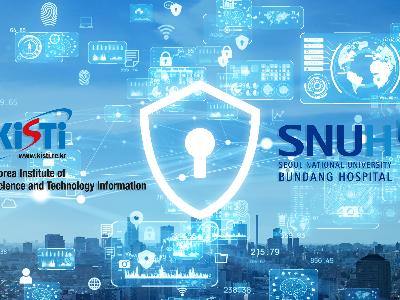
KISTI with SNUBH(Seoul National University Bundang Hospital), is speeding up its...
After concluding MoU last year, KISTI and SNUBH are conducting joint research to establish a system for the practical use of bilateral cryptographic communication and homomorphic cryptography technology. Until now, KISTI has provided quantum cryptographic communication channels and supercomputing infrastructure using the national science and technology research network, and SNUBH has been striving to develop homomorphic cryptographic technology for remote operation based on medical big data. With the joint research on track, KISTI plans to provide a safer big data research environment by constructing a quantum cryptographic communication section for remote transmission and processing of sensitive data based on the National Science and Technology Research Network. SNUBH has already completed the selection of medical research scenarios and functional tests of the isomorphic cryptography library to establish a system for commercialization of homomorphic encryption technology. Dr.Oh Chang-wan, Director of the Life Research Institute of SNUBH said that the commercialization of homomorphic encryption technology will provide an opportunity for medical artificial intelligence technological innovation. Dr. Wonhyuk Lee of Science and Technology Research Network Center of KISTI said that KISTI's high-speed computing technology and infrastructure such as network capabilities will be used to solve the problem of noise processing amplified in the homomorphic encryption process. -
032021. 02
No. 183 View. 61742
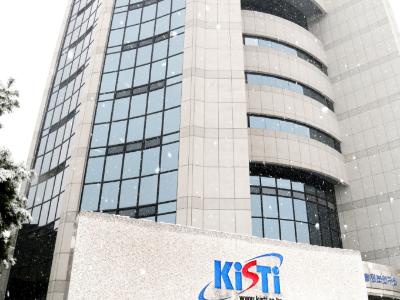
An expert research society was established to study quantum computer security
An expert research society was established to study quantum computer security that can easily penetrate cryptographic systems used in e-commerce, etc. KISTI announced on Feb. 01 that it will establish a “quantum security research group” in the Korea Institute of Information Security and Cryptology and take the role of a secretary to research quantum and security technologies. Public-key cryptographic algorithms used for authentication and digital signatures in electronic financial transactions utilize prime factorization and discrete logarithm problems. The password needs solution to be solved and is highly safe cause it will take decades or more even with supercomputers around the world. However, a quantum computer that uses a quantum mechanical state in which 0 and 1 exist at the same time, rather than the binary systemof 0 and 1, can quickly solve the problem, raising security concerns. On the 15th of last month, the Korea Institute of Information Security and Cryptology established a quantum security research group for academic development between quantum and security technologies. The goal is to study quantum computer security technologies such as quantum distribution keys and quantum resistant encryption, and to present technical standards and directions. Participants of the research group decided to share related technologies and contribute to information exchange between industry-academia and research institutes by holding bilateral and security technology seminars and training. Jae-cheol Ryu, President of the Korea Institute of Information Security and Cryptology(Professor of Computer Convergence, Chungnam National University) said, "Quantum and security technology area future technology that members of the society are very interested in and and we will also continue to provide support for the development of the quantum cryptography research conference.” Seok Woo-jin, Director of the KISTI Science and Technology Research Network Center, who served as a secretary of the Quantum Security Research Group, said, "Through this research group, we will continue to strive to cooperate with participants and create research results so that quantum security technology can be incorporated into KISTI's national science and technology research network." . -
262021. 01
No. 182 View. 56981
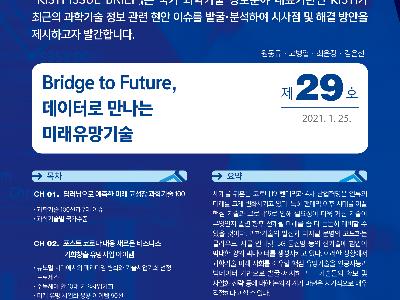
KISTI introduced “Future Promising Technology Seminar 2020” in its Issue Brief N...
KISTI introduced “Future Promising Technology Seminar 2020” in its Issue Brief No. 29, which discovered and presented the core promising technologies that will influence the future society of science and technology after the Corona 19 pandemic. KISTI selected the top 100 future high-growth science and technology areas (clusters) using the optimal deep learning prediction model. About 20 million scientific and technological papers published around the world over the past 14 years were analyzed and issue key words for each top 100 science and technology areas were identified after 7 years. 7 issues were derived according to the distribution of concurrent occurrences of each issue keyword. It also introduced 10 technology commercialization opportunities that should be noted. 1. Contact tracking system 2. Augmented Reality(AR), 3. Digital health 4. Service robot 5. Biosecurity 6. Unmanned vehicle 7. On-site diagnosis device 8. Electronic conference system 9. Cloud data storage device 10. Digital education Platform, etc. The government's R&D investment fields and strategies in the post-corona era were also presented. As promising investment technologies in the digital new deal field, future eco-friendly vehicles, autonomous vehicles, high-performance unmanned vehicles, artificial intelligence (AI), system semiconductors, precision medicine, smart farms, intelligent robots, and smart cities were selected. For the green new deal are fine dust, smart grid, solar power, fuel cells, wind power, and biomass. Dr. Kum Won Cho, Acting President of KISTI, said "I look forward to the efficient use of future promising technologies that will become catalysts for technological innovation and new business creation after the Corona 19 pandemic." -
252021. 01
No. 181 View. 52663
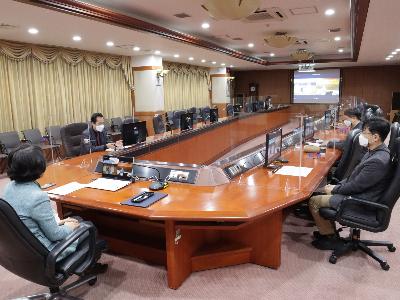
KISTI has concluded MoU with DataStreams to revitalize the data
KISTI has concluded MoU with DataStreams to revitalize the data KISTI has concluded MoU with DataStreams to revitalize the data-driven research ecosystem. With this MoU, KISTI plans to establish a data-based research cooperation system by linking its science and technology information with Datastreams' big data platform 'Teraone.' In addition, KISTI plans to develop intelligent services to strengthen the D, N, A (data, network, artificial intelligence) ecosystem, and promote mutual cooperation to apply new technologies in the domestic and overseas data management fields. Dr. Choi Hee-yoon, President of KISTI, said “With this MoU, we expect to present customized solutions for science and technology data and improve the utilization of national R&D achievements,” and “In particular, it will raise a new perspective on establishing a national R&D environment.” -
262020. 11
No. 180 View. 31941 Emerging Tech Seminar 2020 KISTI has held Emerging Tech Seminar 2020 on 'Bridge to Future, Emerging Technologies through Data,' on November 26th, 2020, through the online platforms. The seminar this year focuses on searching new commercialization and creating companies' value of Small and Middle size Enterprises in the era of post-corona by providing leading emerging technologies and business items through information analysis on science and technology. In addition, it consists of the presentations based on the intelligent analysis on information and data: 100 rapidly developing future technologies predicted by deep-learning technology; the government's investment fields and strategies on R&D in the post-corona era; and new commercialization items that can help SMEs have more business opportunities. At the end of the seminar, a panel discussion on future innovation strategies with data in the Digital New Deal era has been followed, which is expected to advance opinions about what future innovation data that create new business and extract enterprises' innovation are, and how they can achieve their future innovation through information analysis.
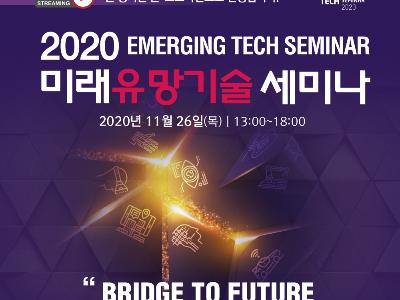
-
192020. 10
No. 179 View. 30686
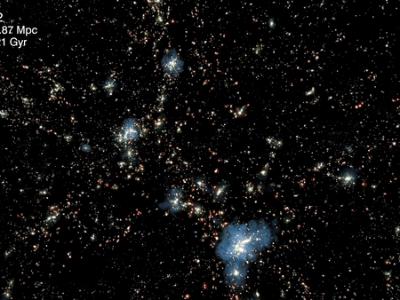
World Biggest Cosmological Fluid Mechanics Simulation
World Biggest Cosmological Fluid Mechanics Simulation KISTI with KIAS, Korea Institute for Advanced Study, and KASI, Korea Astronomy & Space Science Institute, jointly conducted the world biggest numerical simulation, Horizon Run 5, which calculates both calculation of cosmos and creation of galaxies. KISTI allocated 2,500 calculation nodes of NURION, its 5th supercomputer, which corresponds 7.5 petaflops, and ran the simulation for 3 months. The research team selected French fluid mechanics numerical simulation code RAMSES, and they also optimally parallelized it for the maximum efficiency. Newly developed RAMSES makes it possible to calculate gaseous heat and loss by supernova and active galactic nucleus; evolution of contents of heavy elements such as oxygen and iron; and detailed physical evolution process of supermassive black holes. Limitation of spatial size of virtual universe of the previously conducted world biggest cosmological fluid mechanics simulations has made it difficult to find out the correlation between growth of large spatial structures and evolution of galaxies. HR5 is a simulation with expanded scale, so it can realistically reproduce creation and evolution of galaxies based on the standard cosmological model. -
172020. 09
No. 178 View. 28854
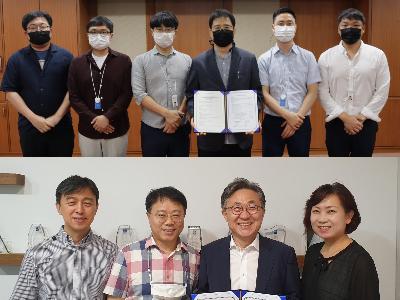
Technology Transfer of Visualization of Security Policy and Large Scale Log
Technology Transfer of Visualization of Security Policy and Large Scale Log KISTI has concluded technology transfer agreement with a private company, UNET System, on the system of visualization of firewall policy and log, named VizPolaris, that makes it possible to secure visibility of firewall policy and analyze invation log, on September 17th, 2020. The system converts text-based firewall-approaching policy and security log to visible images, which can help to intuitively recognize the policy and log. The system has been developed to help more efficiently operate and manage the firewall by managing firewall policy efficiently; deeply tracking IP behaving maliciously; effeciently detecting cyber target attack based on social issues; and providing information on abnormal behavior. The visualization system has functions that recognize and improve both overlapping policies vulnerable to sercurity or unnecessary and problems having strange relations between approaching policies by expressing firewall's approach policies hierarchically. It also helps to identify and handle the first communiation time with malicious IP; major attack behaviors; related social issues; and targeted objects by creating, accumulating, and visualizing various statistical information of massive security logs. In addition, it makes it possible to intuitively indentify malicious hebaviors of invaders or victims by expressing periodic or aperiodic features of network traffics through collecting and analyzing security logs for a long time. The developed technology is expected to make a great contribution to enhancement of security of organizations and companies by supporting swift decising-making and detection and handling of cyber attack of ordinary managers as well as security exeives through securing not only firwall's logs essentially installed and operated by each organization and cyber security center but also visibility of security policy. -
252020. 08
-
222020. 05
No. 176 View. 53112
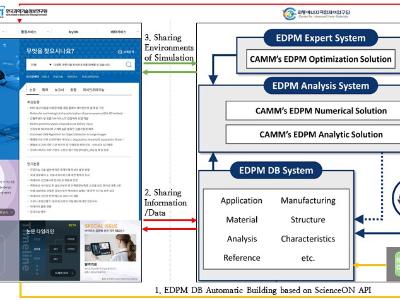
KISTI & KIMM building R&D supporting environments for metastructure researchers
KISTI & KIMM building R&D supporting environments for metastructure researchers - KISTI's ScienceON to support sharing and utilization of research resources - < ScienceON-EDPM Linkage Diagram > KISTI's ScienceON is determined to be connected with EDPM, Engineering Design Platform for Metastructures, being conducted by CAMM, Center for Advanced Meta-Materials, of Korea Institute of Machinery & Materials(KIMM), for supporting R&D of metastructure researchers. ScienceON is a research platform for connecting and utilizing S&T information, the national R&D information, research data, data analysis systems, and supercomputing resources. EDPM is also a research platform providing experimental analysis and simulation of metastructures. Once both of the services are connected, after metastructure researchers search papers of the field; automatically extract the structures from the papers; and make them data on ScienceON, they can analyze experiments and simulate on EDPM. In addition, metastructure R&D information built on EDPM can be provided on ScienceON as well, which is expected to help to drastically enhance R&D efficiency of researchers. -
062020. 05
No. 175 View. 52831
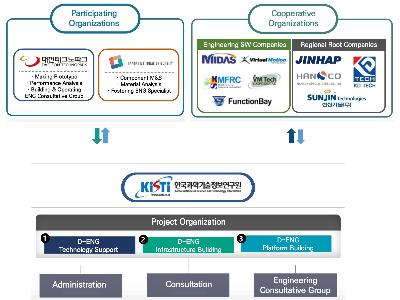
KISTI selected for the Root Industry supporting work using digital engineering t...
KISTI selected for the Root Industry supporting work using digital engineering technology - Investing 9 Billion Won for 3 Years from 2021 - KISTI is selected as the supervising organization for the advancement of innovation of the Root Industry in Daejeon Metropolitan City based on digital engineering, which is one of the supporting works for the regional base organizations of the Ministry of Trade, Industry and Energy of the South Korean Government. In Korea the Root Industry refers to a type of business utilizing the process technologies such as casting, mold, plastic processing, welding, surface treatment, and heat treatment. KISTI with Daejeon City plans to support building equipment of digital engineering and performance analysis; simulation technology of process and components; demand and supply-connected platform; and fostering labor force of engineering, through 9 billion won(approximately 7.3 million US dollars) including 6 billion of the government expenditure for 3 years from 2021. The Supercomputing Modeling & Simulation Center of KISTI, supervising the work, is the only one M&S-based business-supporting center of the government-funded research institutes. It has been providing innovative performance advancement of process and components of about 600 domestic manufacturing businesses since 2007. Based on the professionality from the experience, it will help innovative advancement of the Root enterprises in Daejeon by utilizing digital engineering technology with Daejeon Techno Park and Hanbat National University, which are also participating organizations of the work. KISTI plans to raise the rate of application of digital engineering up to 20%, which is just 4% at present, and improve productivity by 30% by supporting 105 Root businesses in Daejeon.

 Delete Article!
Delete Article!